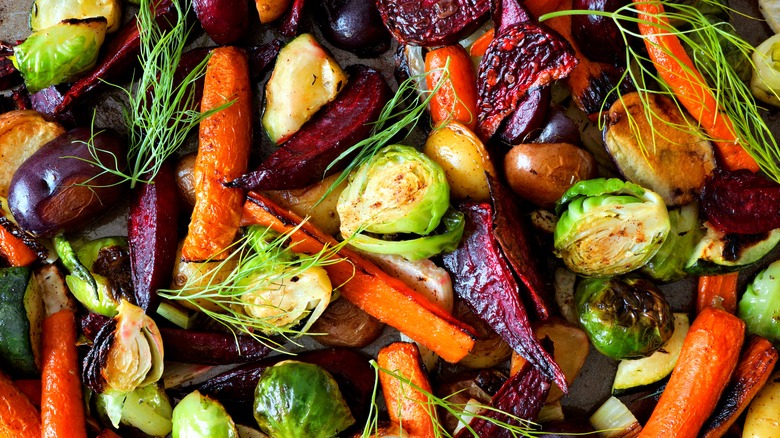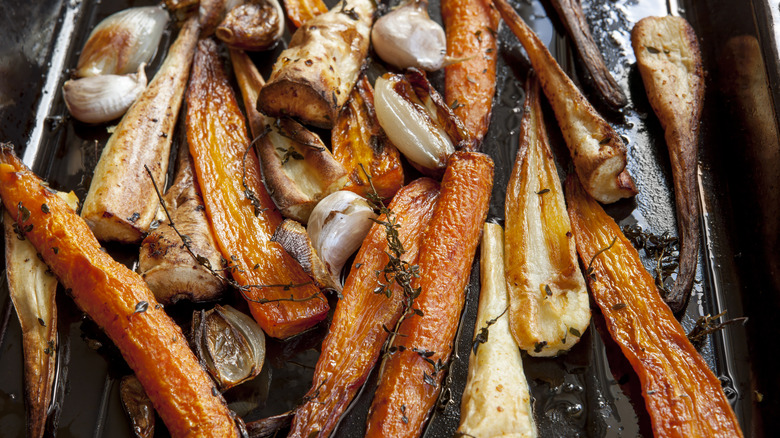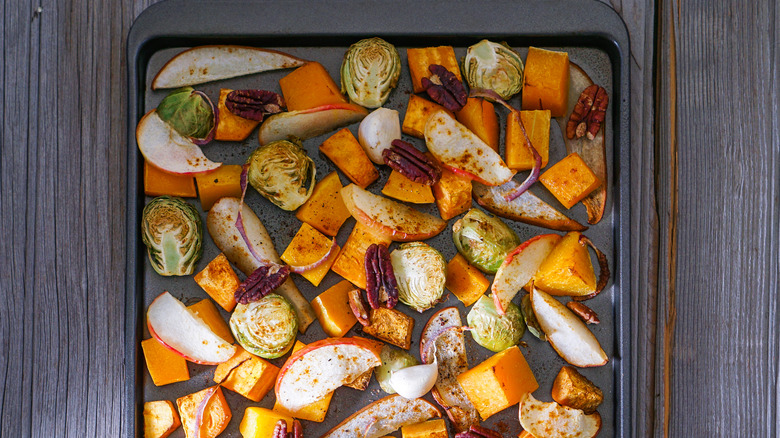The Underrated Part Of Your Oven That's Perfect For Roasting Vegetables
When it comes to getting dinner on the table without a lot of legwork, there aren't many ways to cook veggies that can compare to the payoff of roasting. If you have a hot oven and a sheet pan, you don't even need to follow a recipe, provided you know the basics.
You can roast pretty much any vegetable, and it will come out delicious. All you have to do is toss them in fat, such as olive or avocado oil, or even a little melted butter, season to taste with herbs and spices and maybe a few aromatics, such as onions and shallots, and pop them in a hot oven. You can have them as a side, such as simple roasted butternut squash; serve them as the main dish, such as whole roasted cauliflower; or use them in a recipe, such as puréeing them into a sauce or a roasted tomato soup.
Even though roasting veggies is easy, there are a few points to keep in mind to get them just right. The first and most important is to make sure you're roasting at the right temperature and that the oven is hot when the pan goes in. Most recipes recommend roasting vegetables at around 425 degrees Fahrenheit, which will caramelize the outside of the veggies while also cooking them inside. Too low of a temp won't give you the roasted flavors from the Maillard reaction, and too high will burn the outsides and leave the insides raw.
Use the bottom of your oven
To roast vegetables like the pros, Food & Wine suggests placing your sheet pan on the bottom of your oven — not the bottom rack, but the actual floor of the oven. This may seem strange because we've been conditioned to put things in the middle of the oven to avoid hot and cold spots and achieve even heating around the pan. However, you can use the hot spots in your oven to your advantage to make roasty, toasty vegetables even picky eaters will enjoy. "The oven floor provides the hottest, most even and direct heat possible, which means you can get your vegetables nice and caramelized without overcooking them," food writer Carolynn Carreño wrote in her 2017 cookbook "Bowls of Plenty" (via Food52).
Most conventional home ovens have heat elements built into the top and bottom. And just as you can use the top heating element for broiling, you can also use the bottom of the oven for direct heat (per Bon Appétit). The heat from the floor of the oven when set on "bake" will sear the vegetables and give you more roast, caramelized edges in less time. Just be sure to keep an eye on your oven to make sure nothing is burning.
Speaking of burning, use a silicone mat or trimmed foil for this job — excess parchment paper in proximity to the heating element can catch on fire.
Timing is everything
In addition to a high-quality sheet pan or two, the other essential piece of equipment when roasting vegetables is a timer. While roasting is a simple cooking method, it's easy to forget something when it's in the oven. "Out of sight, out of mind" is a real struggle when you're trying to do multiple tasks at a time.
Burning a batch of expensive ingredients, such as nuts or chanterelles, because you didn't set a timer can even be a fireable offense in some commercial kitchens. Despite the folklore that good chefs don't need timers, most of them wouldn't dare to put something in the oven without setting a timer, and neither should you (per Bon Appétit).
Food & Wine recommends checking on more delicate veggies, such as broccoli and green beans, every five minutes while roasting and using a spatula or tongs to look at the underside of the pieces to make sure they're not burning. You can check on denser veggies, such as winter squash, every 15 minutes or so. If things are sticking to the pan, just be patient; the caramelization will create a crisp exterior that will help them come unstuck. The goal is to roast until you see the edges of the vegetables look light brown and toasted and are soft enough that you can pierce them with a fork or the tip of your paring knife.


